![]()
![]()
![]()
Use LEFT and RIGHT arrow keys to navigate between flashcards;
Use UP and DOWN arrow keys to flip the card;
H to show hint;
A reads text to speech;
91 Cards in this Set
- Front
- Back
|
What is a group? |
An assemblage of persons located or gathered together. |
|
|
What is a team? |
A group, organized to work together |
|
|
How does it feel like in a group? |
Solitary, unorganized, indifferent |
|
|
How does it feel like in a team? |
Unified, cohesive, collaberative, |
|
|
What are the team roles? |
Creator, Advancer, Flexer, Refiner, Ececutor |
|
|
(Team Roles) : Creator |
Genorates new, and inovative ideas. |
|
|
(TeamRoles) Advancer |
Promotes ideas, moving them between creator and refiner. |
|
|
(Team Roles) Refiner |
Reviews, modifies, improves, and rationaly evaluates ideas. |
|
|
(Team Roles) Executor |
Ensures final idea is implemented. |
|
|
(Team Roles) Flexer |
Can preform and of the roles of creator, advancer, refiner or executer, as is needed. |
|
|
What is the Z process |
The process of an idea moving from creator, to advancer, to flexer, to refiner and to executor. |
|
|
What is P.E.P.? |
The natural cycle of brainstorming. Panic(need solution/idea) Elation(I have an idea) Panic(My idea sucks, i suck, why continue living, ..* click* ... BANG! ) NCOs should step in at the elation stage to encourage ideas annd reduce suicide. |
|
|
What is A-I Theory? |
Refers to team dynamics, based on cognative diversity of the members. Members being on a range of places on the adapation and inovation scale. |
|
|
What are the 5 Cs of team of team building? |
Coordination, cooperation, cooaching, comunity. |
|
|
(5 Cs) Community |
Members of the team should feel like a valuable member of the team. |
|
|
(5 Cs) Cooperation |
Make dure everyone knows thei teams mission and purpose. |
|
|
(5Cs) Coordination |
Ensure members know their inportance to the team. |
|
|
(5 Cs) Communication. |
Provide feedback, early and often. |
|
|
(5 Cs) Coaching |
Training, teaching, guiding members of the team. |
|
|
5 common disfuction in a team |
Fear of conflict Lack of commitment Avoidance of accountability. Absence of trust Inattention to results. |
|
|
Stages of team development |
Forming Storming Norming Preforming Trasforming/Adjourning |
|
|
Feedback |
Offer or suggest information or ideas as a resction from an inquiry. Followers are expected to giv3 feedback to leaders and vise, versa. |
|
|
Authoritarian leader |
Used in emergancy situations, time sensitive, critical tasks. High task, low relationship. |
|
|
Country club leader |
Low task, high relationship. Focuses on rewards. |
|
|
Improvished leader |
Low task, low relatioship,. Aplicable in self-sufficient work center. |
|
|
Team leader |
High task, high relationship. On a work center with a mixture of needs. |
|
|
Deliberate Development Plan |
A plan of action for each airman, based on their needs, to develope them in a compehensive manner. Set uo the plan, sit down with the airman Monitor the plan, and follow through. |
|
|
Position power. |
Authority to make decisions based on your position in an organization. |
|
|
Personal power |
Extent that gollowers respect, and are committed to their leader. Also, super strength, heat vision, flight, and invisability |
|
|
Types of personal power |
Referent power, information power, expert power |
|
|
Contemporary motivation model |

|
|
|
BATNA |
Best Alternative To a Negotiated Agreement. Next best outcome, or plan should negotiation should fail. It effects the urgancy and willingness to compromize. |
|
|
Convergent thinker |
Reliable, rational, principle based. Dislike uncertainty and ambiguity. |
|
|
Divergent thinkers |
Creative, spontanous. Confortable with uncertainty. |
|
|
Interest-Based Negotiations (IBN) |
Focusing in interests and not positions of the two negotiating parties. |
|
|
Zone of possible agreement |
The bargaining range. The overlapping common area for both parties. |
|
|
TIPO |
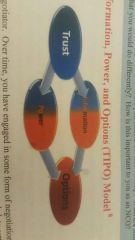
Trust: in person or process. Determins information avaible Power: based on leader, position or personal power. |
|
|
Negotiation preference and styles chart. |
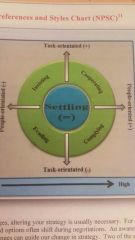
|
|
|
Conflict Management connections |
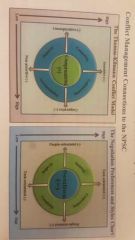
|
|
|
5 step CNS process |
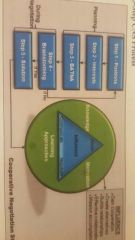
|
|
|
Negotiating categories |
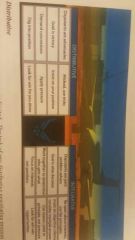
|
|
|
Dustributive tactics |
Good, cop, bad cop. Highball, lowball Exploding offer Lying Intimidation/aggressive Snow job Nibble |
|
|
Nibble |
Asking for one last thing right before closing the deal. |
|
|
High context culture |
More people oriented. They prefer to establish trusted relationships. |
|
|
Low context cultures |
Task oriented and work towards quick resilutions. |
|
|
Readiness |
Capacity of parties to decide it is in there best interest to negotiate. |
|
|
Ripeness |
Whether or not the parties are interested in negotiating. |
|
|
Impasse |
Occurs when there is a failure to make progress towards a resolution. |
|
|
Minimal encouagements |
They biuld rapport, encourage the speaker to cobtinue, ( oh,.. really?... when?) |
|
|
Emotio labeling |
An active listening skill, where you clarify the speakers emontions. Saying, ( you sound... you seem, ... what i hear is...) |
|
|
Antudeficiency act violations |
An act that results in exceeding limitations (misuse) of funds. |
|
|
Continuing resolution authority |
Fiscal law authority that allows the goverment to cobtinue spending at a minimum level for a specific smount of time. |
|
|
Cost center |
Organization that gathers an distributes cost data. |
|
|
Cost center manager |
Regulates daily use of work hours, supplies, equipment. |
|
|
Financial working group. (Fwg) |
Reviews program cost factor, compares actual with prior year costs. |
|
|
Financisl management board (fmb) |
Advisory committee chaired, by the commander or deputy commander and includes group commander level members. |
|
|
Budget exection review (BER) |
Two part process, yhat occurs twice within each budget cyle to indentify and redistibute funds to meet unfunded requirements. |
|
|
Finacial execution plan (FEP) |
Product formally called the financial plan or fin plan. The fep ensures an equitable distribution of the president's budget. For the next fiscal year. |
|
|
Budget cycle |
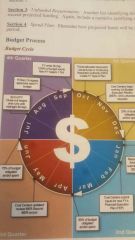
|
|
|
First quarter cycle |
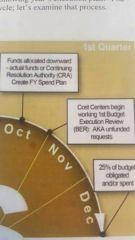
Oct, fiscal year begins Nov. First BER. Dec. 25% budget obligated or spent. |
|
|
Second quater |
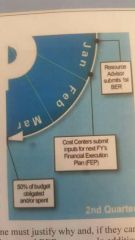
Jan: RA subimts 1st BER. Jan: cost centers submit inputs for next FYs financial Execution Plan (FEP) Mar: 50% of budget obligated or spent. |
|
|
Third quarter |
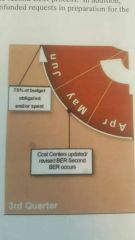
May: cost centers updated/revised BER second BER occurs. Jun: 75% of budget obligated or spent. |
|
|
Fourth quarter |
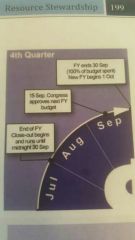
Aug-30 sep: end year close out 15sep congress approves next FY budget. 30 sep: 100% of budget spent. |
|
|
What does afi 65-601 say about reporting funds. |
Report excess funds to the wing. Doing so help support other mission-essential requirements |
|
|
UNIT MANNING DOCUMENT |
Lists ranks, and skill levels of authorized personel slots, of what a unit SHOULD have. |
|
|
Unit Personel Management Roster UPMR. |
Actual numbers, ranks, and skill levels of current personel. Contsins funded and unfunded personel positions. |
|
|
Authorization change request |
Used to make changes to the umd. |
|
|
Dm area 1- prevention. |
Set clear standards Establish rapport Create climate of accountability. |
|
|
How ddo you prevent Disciplinary Problems |
Be a role model Communicate standards Communicate expectations Promote core values Use rank position correctly Effrctively mentor Properly train Promote teamwork Use sound leadrship skills Display and insist on technical competence Provide feedback |
|
|
Disciplinary model - correction. |
Feedback, Formal counseling Recomendations to commander Referral preformance |
|
|
Disciplinary Model - punishment |
Article 15s Loss of pay, freedom. |
|
|
Progressive Disciple Process |
Establish standards Monitor Apply PDP. Loc-loa-lor- article 15- court martial |
|
|
Ace? |
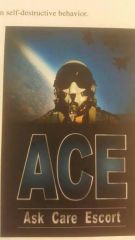
|
|
|
4 dimensions of wellness |
Wellness: Emotional Physical Spiritual Social |
|
|
Drug abuse pervention |
Education Counseling Referral Follow-up |
|
|
Work place violance precursers |
Loss of job, pass over for promotion, preceived favortism of others. Sleeep depervation Death in the family Drug use Perception of unjust org or superviser. Discrimination Name starts with "V" and ends in espoli. |
|
|
3 parts of adaptability |
Flexability. Cogbitive: ability to change mental aproach. Emotional: ability to vary aproach to your emotions. Dispositional: abilityvto remain optomistic dospight situation. |
|
|
NCOs with emotional flexability display what 4 behavoirs |
1: manage their emotions 2: connect with othets emotions 3: engage emotionaly 4: balance emotions and actions. All really the same damn thing. |
|
|
Change sponsor |
Responsible for initiating change. They are the authority responsible to make the choice. They can be any nco rank, they will be the originator of the change, not the one overseeing it. |
|
|
Change agents |
Responsible for implementation of change, an nco, but not the originator of change. |
|
|
Change targets |
The people or group being changed! |
|
|
Janssen's Model of change |
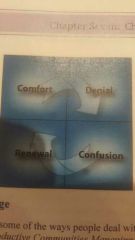
|
|
|
Directive Change |
Change implrmented by an authority figure. |
|
|
Participative change |
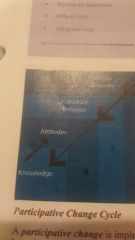
Change implemented when nw knowledge is made available to the group. |
|
|
AFSO21 |
Air force smart ops for the 21st century. -increase productivity of your people. -increase available assets -improve responce time - sustained ops -energy efficaincy |
|
|
Reactive decision making |
Trial and error, based on expeirance situational cues. Making quick judgements on familiar issues. |
|
|
Reflective decision making |
Used in unfamilair situations, or deliberate planning. Critical thinking, solving the problem at hand and monitoring, and self correction. |
|
|
Keppner-tregoe problem solving process |
Situation appraisal Problem analysis Decision analysis Potential problem analysis |
|
|
OODA loop |
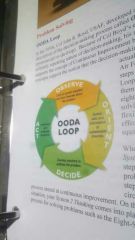
Observe, orient, decide, act. |
|
|
Eight step problem solving process |
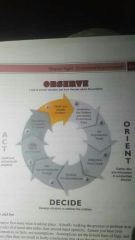
A way to make an unecessarily complicated process, more complicated, and less likely to actualy be used or retained. Clarify, Break down the problem Set inprovement target Determine root cause Develope countermeasures See counter measures through Confirm results and process Standardized successful process |
|
|
Tactical targets |
Balanced Specific Meadueable Atttainable Results focused Timely |

